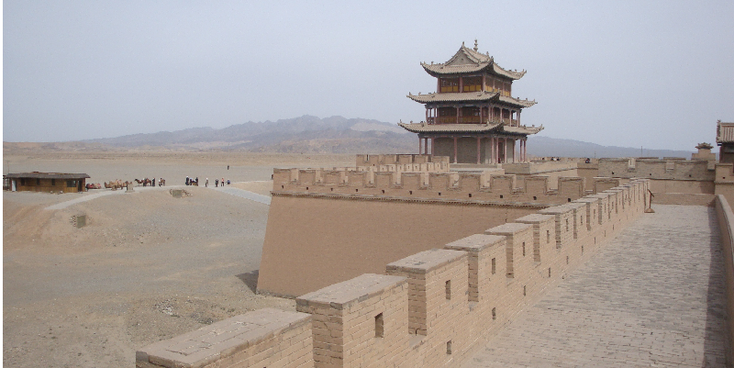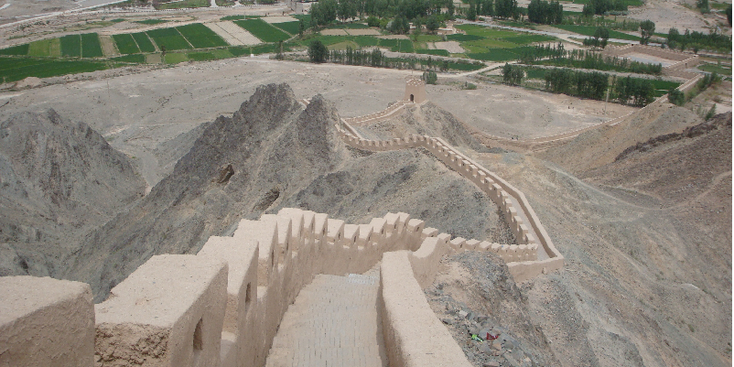Jiayuguan
Travel Stories - China

introduction
I’ve asked the train inspector, who is walking around in each wagon, that I would like to be woken up if possible at 04:00 as we arrive in Jiayuguan about half an hour later (if all is well). Of course I also put my own alarm. The station is about 5 kilometers outside the city and if I walk up the platform I have tot hink of I’m in Russia instead of China. It is cold and people walk up with thick coats and hats.
The streets also seem broader than our squares and there are large cold cement buildings – almost Communists - around the station. The taxi drivers keep asking me where I want to go, but I wait on the first bus that is just approaching. It looks like a suburb but the driver says that this is the center and I get off in Jiayuguan. My intended hostel looks fine from the outside and even chic when I enter the lobby. The receptionist points at the wall with prices, but I quickly say that I am not an ordinary tourist.
I got a much better price after some talk at the reception. I take one without a shower so the price drops even further to a level that I usually pay and I check in. Refreshed I come down when I notice that there is an English speaking receptionist and I have to use that. I ask how I can get to the fort and the wall and ask that these sights be written down in Chinese so that I can show them to people.

The Jiayuguan fort

The fort entrance is pricey but I have to see this; this is THE last fort of the great wall! The end of civilization and the beginning of the barbaric world. This was also a very important point for the silk-routes that all came through this narrow valley to continue their way. First I walk through a hole of a low clay wall to see suddenly the big fort in front of me. In front of the high walls is a temple with beautiful frescoes.
The main tower looks very Chinese but the rest of the fort could stand as well in the Middle East as crusader fort such as the Karak castle in Jordan. It is made of a mix between stone and clay houses and is only surrounded by a large bare plain with mountains with snowy peaks in the distance. Some tents have been erected in one of the inner gardens and you can try you’re luck with shooting some arrows in addition for wearing traditional clothing and take a picture.
Of course there are some ancient cannons and if you go through the north gate you can ride a short ride on a horse or camel. A little further on is a museum where I read that a gigantic high number of soldiers was here to guard the fort. In addition to live a soldier-life, they usually did farm in their spare-time. Looking in the distance I wonder how life was here in those old times.
Back at the road I ask at a kind of informationdesk what is the best and cheapest way to get to the part of the wall. She says that there is no bus and that a taxi costs about 8Y. When we arrive at the large parking lot, many taxi drivers come to me, but if I mention the above-mentioned price, they walk immediately off one by one.

Chinese Wall:
The 6,259-kilometer-long defense wall, what we call now the Great or Chinese Wall had to protect the Chinese Empire from enemy nomadic horsemen from the North. The entire defense line, including defense ditches of 359 kilometers and 2,232 kilometers of natural boundaries (rivers, hills and mountains), has a length of 8,850 kilometers.
The first part of this line was built in 200 BC. made of stamped earth. The first constructions were earthen and mud elevations reminiscent of the Roman lines, but eventually stone made its appearance and watch towers were built. Under very bad conditions, more than half a million workers worked on the Wall. It is even claimed that on every meter one man died. During the Tang dynasty, the wall fell into disrepair, but at the time of the Ming dynasty (1368 - 1644) the wall was again repaired and extended.
In this time, separate pieces of wall were also connected with each other to the enormous structure that we know today. More than a million people guarded the wall from more than 1,000 forts and watchtowers. As the hostile armies approached, they set fire to a mixture of wood, straw and manure and with smoke-signals the soldiers were alarmed. One thick cloud of smoke meant 500 soldiers, four puffs of smoke meant 10,000 enemy soldiers. But a hundred years later the Huns were still not defeated.
The Ming conducted extensive wars against the Mongols and Manchus, partly descendants of the Huns. Eventually the wall was built and the empire retreated behind the wall, revealing thousands of square kilometers of land to the nomads. It would not help them: in 1644 the Manchus used internal division in the country and conquered China anyway.

Eventually one taxidriver wants to bring me, but on the way he starts to mumble and grumble. I think he wants more money but I’ve got more confidence in the girl from the information centre than a taxi-driver. The wall here is much narrower, lower and sandy with respect to the wall that I saw near Beijing.
The same thing is that the wall is like a snake over the hills and that it has been renovated too thoroughly. When I walk up the real wall, aiming at one of the watchtowers above, I think of my old "Playmobil" castle or a sand castle, so unrealistic it is. At the top of the tower I am the only one and I enjoy the wonderful but beautiful view of the oasis, the wall, the city, the mountains, the rocks and the gigantic large empty plain. I realize that where I stood was seen by the Chinese as the end of civilization.
There are two taxis in the parking lot and the price has increased even further because the drivers know that there is no bus and I am alone here. But I do not give up so quickly and I walk to the road and raise my thumb. After a few misses and a motorist who asks for more money than the taxi drivers, an old van with a family stops in it and wants to take me. I’m going back to the center without paying anything.

tips & advice (2009)

The airport of Jiayuguan is about 13 km northeast of the center. It must be about 5 to 6 kilometers south of the city where the train station is situated; Jiayuguan is located on the "busy" Urumqi - Lanzhou line. Bus 1 will take you there from the center. The bus station, on the other hand, is centrally located in the south of the city at the intersection of the Lanxin Xilu and Jingtie Shangchang.
Jiayuguan - Dunhuang: there are three buses a day (09:00, 10:30 and 11:30); the duration is about 5 to 7 hours and costs are 67 Y.

-
Name: Hostel Jinye Binguan
Address: 12 Lanxin Xilu
Price: 60 Yuan (double)
Phone nr. : 620 1333
Content:
From the outside it looks like a 5 star hotel but that could be a bit disappointment - it is clean and quiet and the prices are very reasonable. It is not far from the bus station. Prices of the room include toilet and shower but excluding breakfast. They also have three person room but no singles.

see also:
LANDEN:
EUROPA:
Albanië * België * Bosnië-Herzegovina * Bulgarije * Denemarken * Duitsland * Engeland * Estland * Finland * Frankrijk * Griekenland * Hongarije * (Noord) Ierland * Italië * Kosovo * Kroatië * Letland * Litouwen * Luxemburg * Macedonië * Malta * Montenegro * NEDERLAND * Oekraïne * Oostenrijk * Polen * Portugal * Roemenië * Rusland * Schotland * Servië * Slovenië * Slowakije * Spanje * Tsjechië * Turkije * Zweden
NOORD EN CENTRAAL-AMERIKA:
Chili * Costa Rica * Cuba * Guatemala * Mexico * Nicaragua * Panama * Verenigde Staten
ZUID-AMERIKA:
Argentinië * Bolivia * Brazilië * Colombia * Ecuador * Peru
AFRIKA:
Botswana * Burkina Faso * Egypte * Ethiopië * Ghana * Kenia * Mali * Marokko * Namibië * Oeganda * Senegal * Tanzania * Tunesië * Zuid-Afrika
MIDDEN-OOSTEN:
Iran * Israël * Jordanië * V.A.E.
AZIE:
Armenië * Cambodja * China * Filipijnen * Georgië * India * Indonesië * Japan * Kirgizië * Laos * Maleisië * Mongolië * Myanmar * Nepal * Oezbekistan * Singapore * Sri Lanka * Thailand * Vietnam
OCEANIE:
Voor meer reisfoto's kijk op www.instagram.com/cheapskatetravel.nl:
© Cheapskatetravel.nl; 2018 (all rights reserved)


